Managing People, Organization, and Context
VerifiedAdded on 2023/06/12
|18
|5431
|228
AI Summary
This essay explores the concepts of managing conflicts as well as management of teams and groups competencies. It also discusses how to mentor employees effectively and manage disputes to achieve superior performance in an organization.
Contribute Materials
Your contribution can guide someone’s learning journey. Share your
documents today.
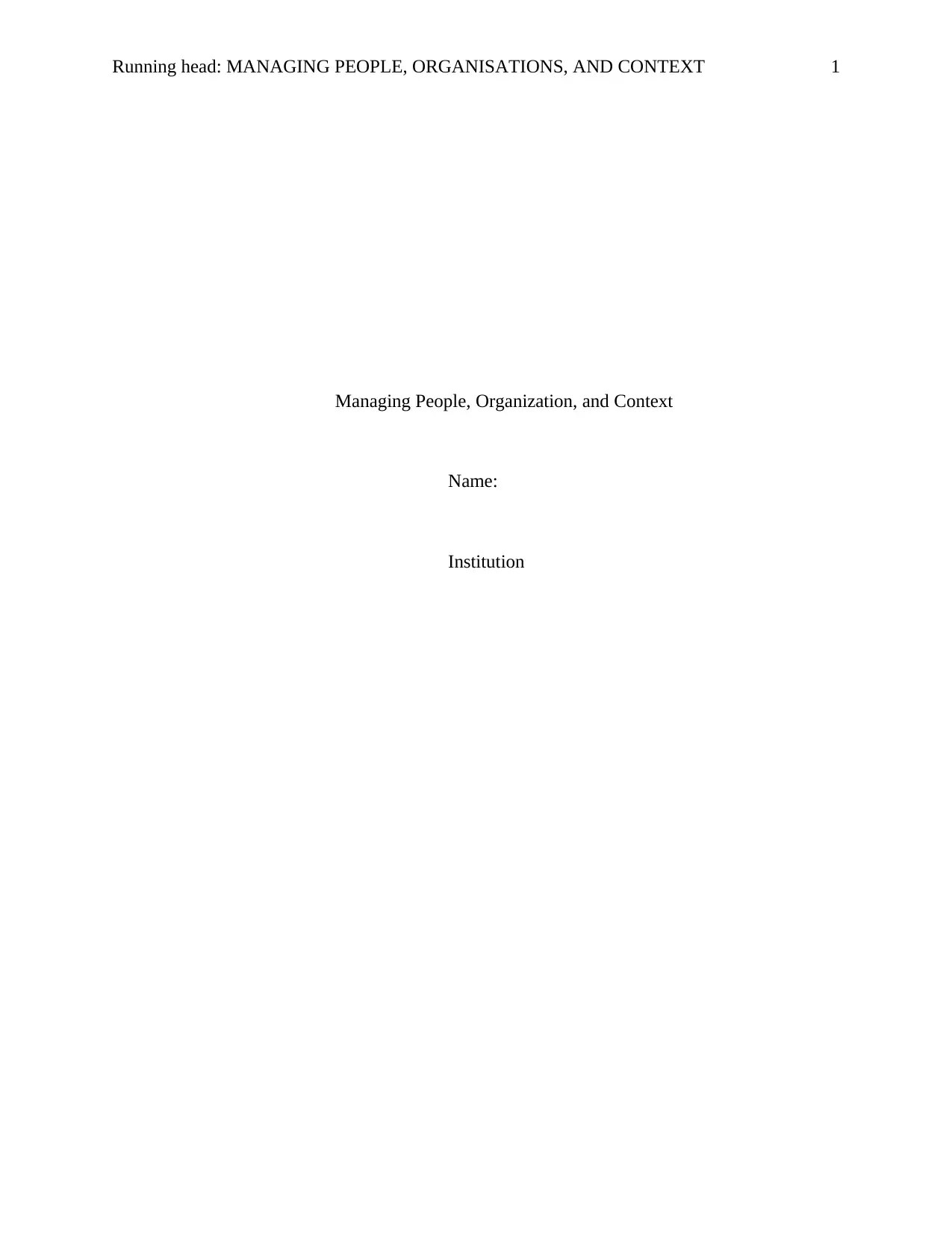
Running head: MANAGING PEOPLE, ORGANISATIONS, AND CONTEXT 1
Managing People, Organization, and Context
Name:
Institution
Managing People, Organization, and Context
Name:
Institution
Secure Best Marks with AI Grader
Need help grading? Try our AI Grader for instant feedback on your assignments.
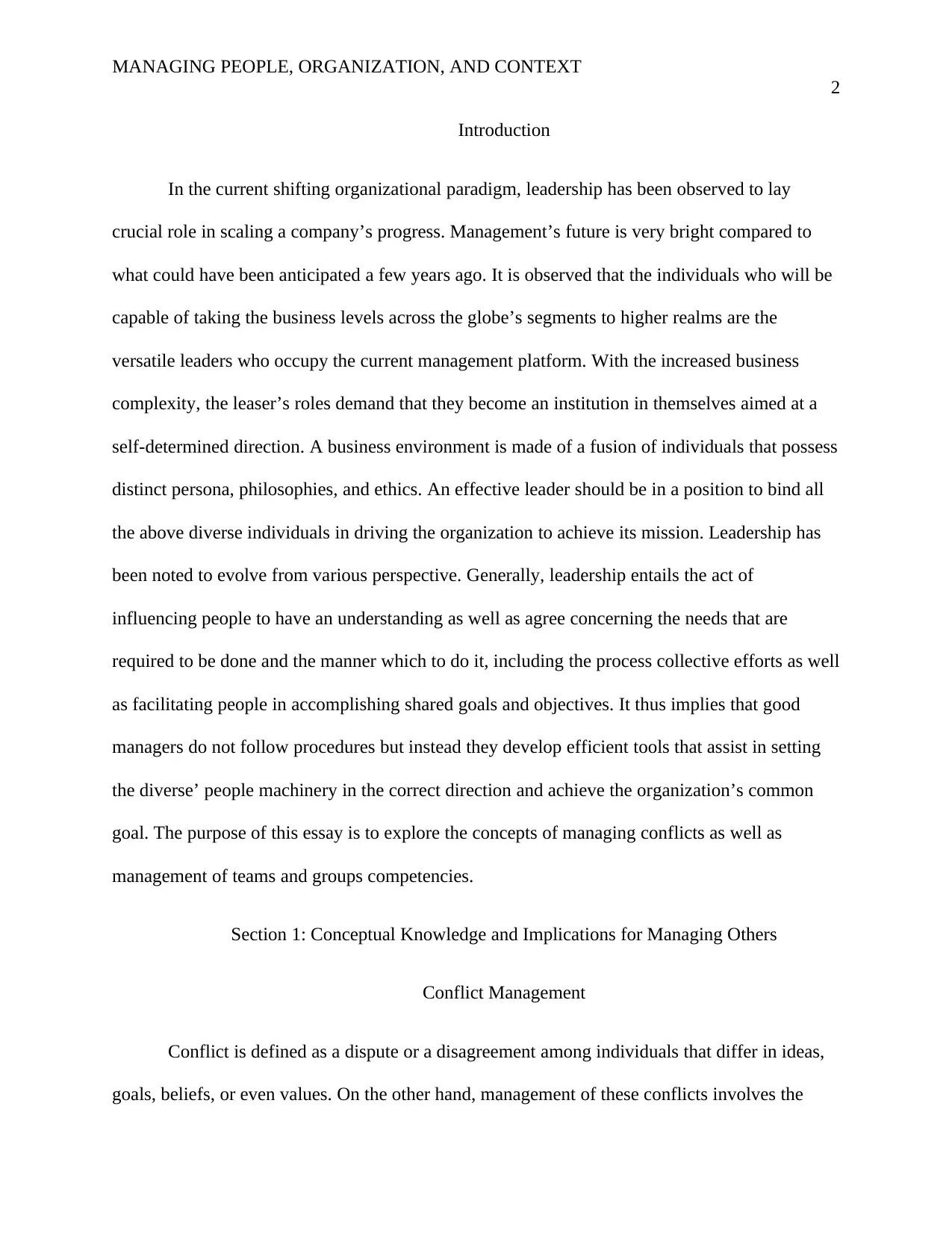
MANAGING PEOPLE, ORGANIZATION, AND CONTEXT
2
Introduction
In the current shifting organizational paradigm, leadership has been observed to lay
crucial role in scaling a company’s progress. Management’s future is very bright compared to
what could have been anticipated a few years ago. It is observed that the individuals who will be
capable of taking the business levels across the globe’s segments to higher realms are the
versatile leaders who occupy the current management platform. With the increased business
complexity, the leaser’s roles demand that they become an institution in themselves aimed at a
self-determined direction. A business environment is made of a fusion of individuals that possess
distinct persona, philosophies, and ethics. An effective leader should be in a position to bind all
the above diverse individuals in driving the organization to achieve its mission. Leadership has
been noted to evolve from various perspective. Generally, leadership entails the act of
influencing people to have an understanding as well as agree concerning the needs that are
required to be done and the manner which to do it, including the process collective efforts as well
as facilitating people in accomplishing shared goals and objectives. It thus implies that good
managers do not follow procedures but instead they develop efficient tools that assist in setting
the diverse’ people machinery in the correct direction and achieve the organization’s common
goal. The purpose of this essay is to explore the concepts of managing conflicts as well as
management of teams and groups competencies.
Section 1: Conceptual Knowledge and Implications for Managing Others
Conflict Management
Conflict is defined as a dispute or a disagreement among individuals that differ in ideas,
goals, beliefs, or even values. On the other hand, management of these conflicts involves the
2
Introduction
In the current shifting organizational paradigm, leadership has been observed to lay
crucial role in scaling a company’s progress. Management’s future is very bright compared to
what could have been anticipated a few years ago. It is observed that the individuals who will be
capable of taking the business levels across the globe’s segments to higher realms are the
versatile leaders who occupy the current management platform. With the increased business
complexity, the leaser’s roles demand that they become an institution in themselves aimed at a
self-determined direction. A business environment is made of a fusion of individuals that possess
distinct persona, philosophies, and ethics. An effective leader should be in a position to bind all
the above diverse individuals in driving the organization to achieve its mission. Leadership has
been noted to evolve from various perspective. Generally, leadership entails the act of
influencing people to have an understanding as well as agree concerning the needs that are
required to be done and the manner which to do it, including the process collective efforts as well
as facilitating people in accomplishing shared goals and objectives. It thus implies that good
managers do not follow procedures but instead they develop efficient tools that assist in setting
the diverse’ people machinery in the correct direction and achieve the organization’s common
goal. The purpose of this essay is to explore the concepts of managing conflicts as well as
management of teams and groups competencies.
Section 1: Conceptual Knowledge and Implications for Managing Others
Conflict Management
Conflict is defined as a dispute or a disagreement among individuals that differ in ideas,
goals, beliefs, or even values. On the other hand, management of these conflicts involves the
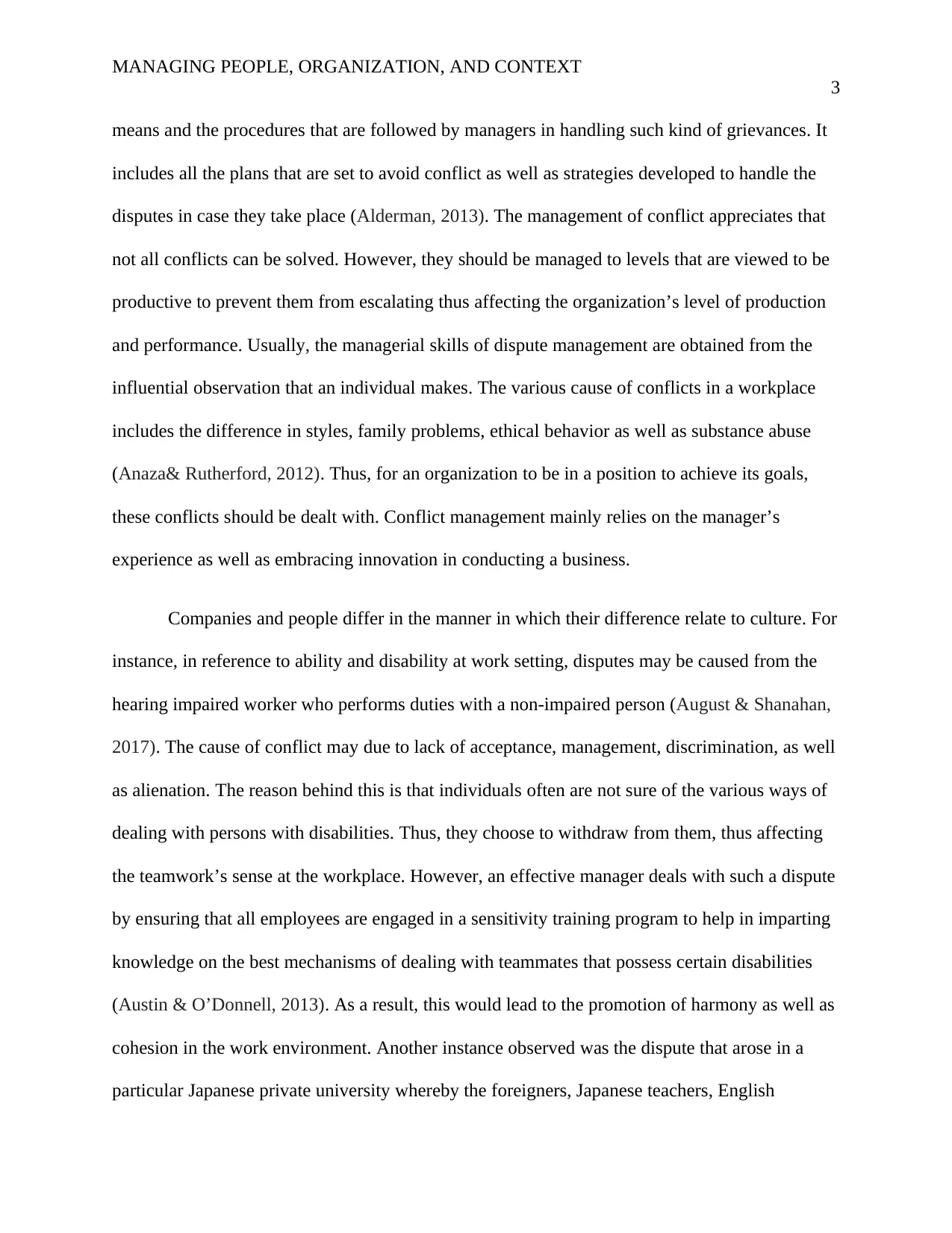
MANAGING PEOPLE, ORGANIZATION, AND CONTEXT
3
means and the procedures that are followed by managers in handling such kind of grievances. It
includes all the plans that are set to avoid conflict as well as strategies developed to handle the
disputes in case they take place (Alderman, 2013). The management of conflict appreciates that
not all conflicts can be solved. However, they should be managed to levels that are viewed to be
productive to prevent them from escalating thus affecting the organization’s level of production
and performance. Usually, the managerial skills of dispute management are obtained from the
influential observation that an individual makes. The various cause of conflicts in a workplace
includes the difference in styles, family problems, ethical behavior as well as substance abuse
(Anaza& Rutherford, 2012). Thus, for an organization to be in a position to achieve its goals,
these conflicts should be dealt with. Conflict management mainly relies on the manager’s
experience as well as embracing innovation in conducting a business.
Companies and people differ in the manner in which their difference relate to culture. For
instance, in reference to ability and disability at work setting, disputes may be caused from the
hearing impaired worker who performs duties with a non-impaired person (August & Shanahan,
2017). The cause of conflict may due to lack of acceptance, management, discrimination, as well
as alienation. The reason behind this is that individuals often are not sure of the various ways of
dealing with persons with disabilities. Thus, they choose to withdraw from them, thus affecting
the teamwork’s sense at the workplace. However, an effective manager deals with such a dispute
by ensuring that all employees are engaged in a sensitivity training program to help in imparting
knowledge on the best mechanisms of dealing with teammates that possess certain disabilities
(Austin & O’Donnell, 2013). As a result, this would lead to the promotion of harmony as well as
cohesion in the work environment. Another instance observed was the dispute that arose in a
particular Japanese private university whereby the foreigners, Japanese teachers, English
3
means and the procedures that are followed by managers in handling such kind of grievances. It
includes all the plans that are set to avoid conflict as well as strategies developed to handle the
disputes in case they take place (Alderman, 2013). The management of conflict appreciates that
not all conflicts can be solved. However, they should be managed to levels that are viewed to be
productive to prevent them from escalating thus affecting the organization’s level of production
and performance. Usually, the managerial skills of dispute management are obtained from the
influential observation that an individual makes. The various cause of conflicts in a workplace
includes the difference in styles, family problems, ethical behavior as well as substance abuse
(Anaza& Rutherford, 2012). Thus, for an organization to be in a position to achieve its goals,
these conflicts should be dealt with. Conflict management mainly relies on the manager’s
experience as well as embracing innovation in conducting a business.
Companies and people differ in the manner in which their difference relate to culture. For
instance, in reference to ability and disability at work setting, disputes may be caused from the
hearing impaired worker who performs duties with a non-impaired person (August & Shanahan,
2017). The cause of conflict may due to lack of acceptance, management, discrimination, as well
as alienation. The reason behind this is that individuals often are not sure of the various ways of
dealing with persons with disabilities. Thus, they choose to withdraw from them, thus affecting
the teamwork’s sense at the workplace. However, an effective manager deals with such a dispute
by ensuring that all employees are engaged in a sensitivity training program to help in imparting
knowledge on the best mechanisms of dealing with teammates that possess certain disabilities
(Austin & O’Donnell, 2013). As a result, this would lead to the promotion of harmony as well as
cohesion in the work environment. Another instance observed was the dispute that arose in a
particular Japanese private university whereby the foreigners, Japanese teachers, English
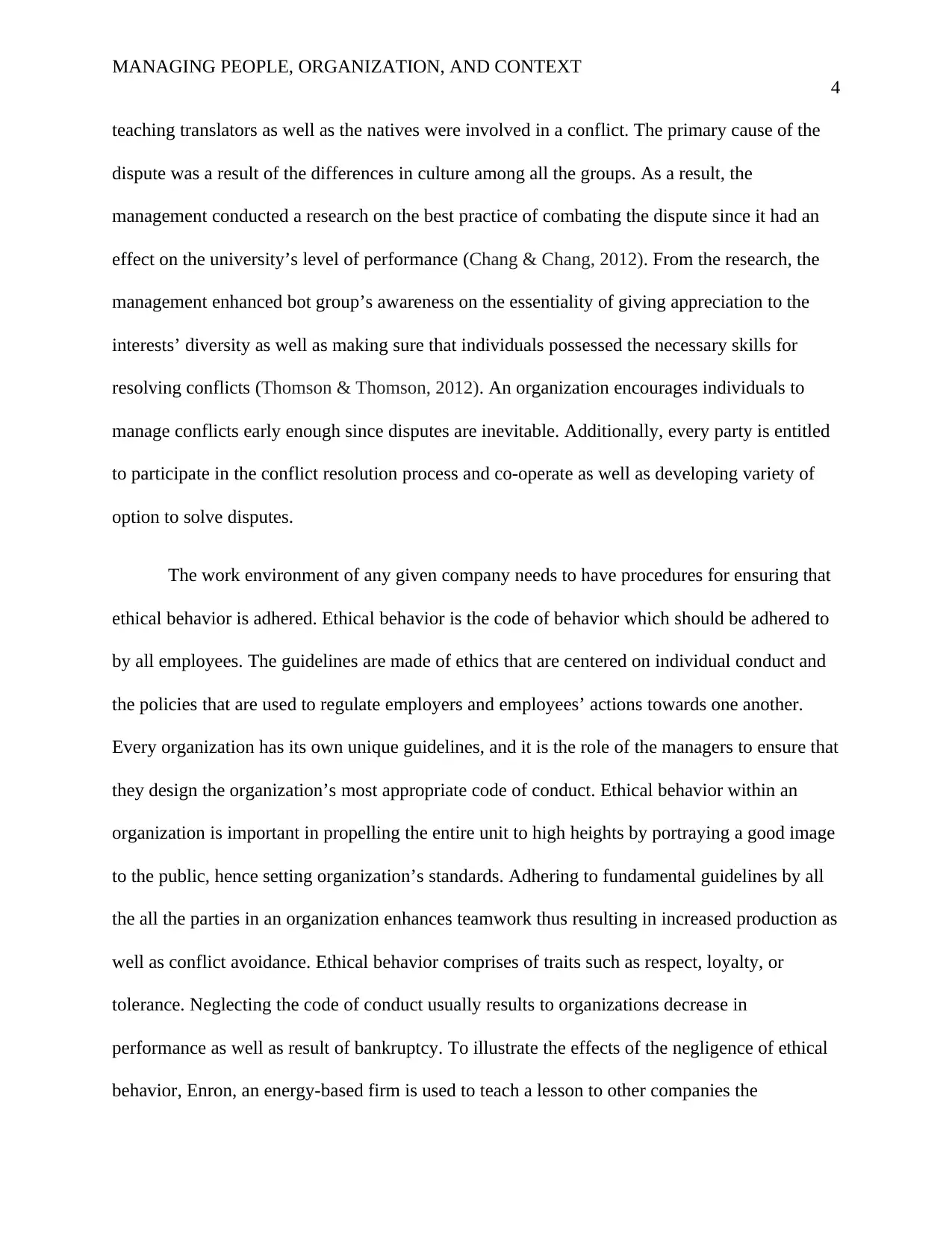
MANAGING PEOPLE, ORGANIZATION, AND CONTEXT
4
teaching translators as well as the natives were involved in a conflict. The primary cause of the
dispute was a result of the differences in culture among all the groups. As a result, the
management conducted a research on the best practice of combating the dispute since it had an
effect on the university’s level of performance (Chang & Chang, 2012). From the research, the
management enhanced bot group’s awareness on the essentiality of giving appreciation to the
interests’ diversity as well as making sure that individuals possessed the necessary skills for
resolving conflicts (Thomson & Thomson, 2012). An organization encourages individuals to
manage conflicts early enough since disputes are inevitable. Additionally, every party is entitled
to participate in the conflict resolution process and co-operate as well as developing variety of
option to solve disputes.
The work environment of any given company needs to have procedures for ensuring that
ethical behavior is adhered. Ethical behavior is the code of behavior which should be adhered to
by all employees. The guidelines are made of ethics that are centered on individual conduct and
the policies that are used to regulate employers and employees’ actions towards one another.
Every organization has its own unique guidelines, and it is the role of the managers to ensure that
they design the organization’s most appropriate code of conduct. Ethical behavior within an
organization is important in propelling the entire unit to high heights by portraying a good image
to the public, hence setting organization’s standards. Adhering to fundamental guidelines by all
the all the parties in an organization enhances teamwork thus resulting in increased production as
well as conflict avoidance. Ethical behavior comprises of traits such as respect, loyalty, or
tolerance. Neglecting the code of conduct usually results to organizations decrease in
performance as well as result of bankruptcy. To illustrate the effects of the negligence of ethical
behavior, Enron, an energy-based firm is used to teach a lesson to other companies the
4
teaching translators as well as the natives were involved in a conflict. The primary cause of the
dispute was a result of the differences in culture among all the groups. As a result, the
management conducted a research on the best practice of combating the dispute since it had an
effect on the university’s level of performance (Chang & Chang, 2012). From the research, the
management enhanced bot group’s awareness on the essentiality of giving appreciation to the
interests’ diversity as well as making sure that individuals possessed the necessary skills for
resolving conflicts (Thomson & Thomson, 2012). An organization encourages individuals to
manage conflicts early enough since disputes are inevitable. Additionally, every party is entitled
to participate in the conflict resolution process and co-operate as well as developing variety of
option to solve disputes.
The work environment of any given company needs to have procedures for ensuring that
ethical behavior is adhered. Ethical behavior is the code of behavior which should be adhered to
by all employees. The guidelines are made of ethics that are centered on individual conduct and
the policies that are used to regulate employers and employees’ actions towards one another.
Every organization has its own unique guidelines, and it is the role of the managers to ensure that
they design the organization’s most appropriate code of conduct. Ethical behavior within an
organization is important in propelling the entire unit to high heights by portraying a good image
to the public, hence setting organization’s standards. Adhering to fundamental guidelines by all
the all the parties in an organization enhances teamwork thus resulting in increased production as
well as conflict avoidance. Ethical behavior comprises of traits such as respect, loyalty, or
tolerance. Neglecting the code of conduct usually results to organizations decrease in
performance as well as result of bankruptcy. To illustrate the effects of the negligence of ethical
behavior, Enron, an energy-based firm is used to teach a lesson to other companies the
Secure Best Marks with AI Grader
Need help grading? Try our AI Grader for instant feedback on your assignments.
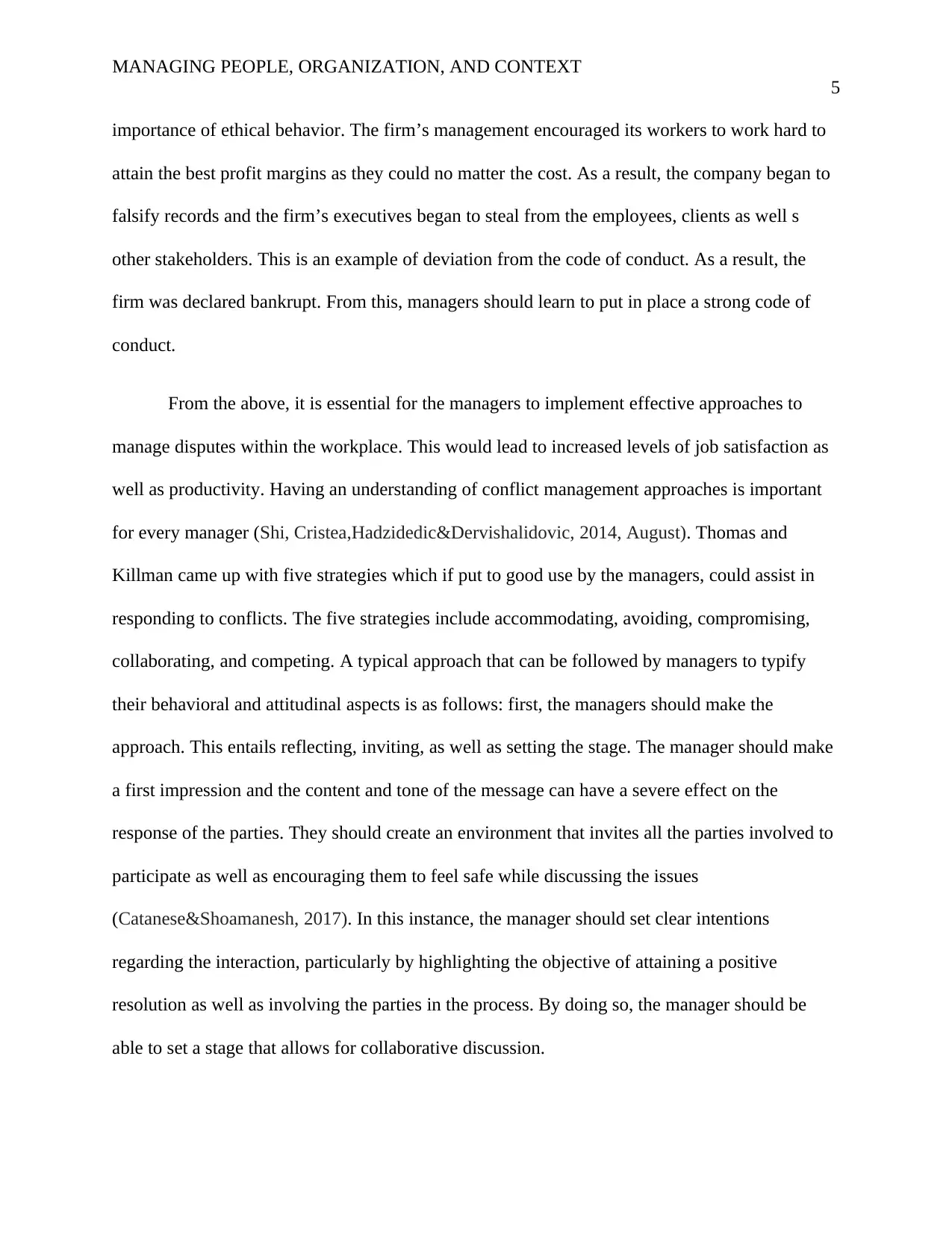
MANAGING PEOPLE, ORGANIZATION, AND CONTEXT
5
importance of ethical behavior. The firm’s management encouraged its workers to work hard to
attain the best profit margins as they could no matter the cost. As a result, the company began to
falsify records and the firm’s executives began to steal from the employees, clients as well s
other stakeholders. This is an example of deviation from the code of conduct. As a result, the
firm was declared bankrupt. From this, managers should learn to put in place a strong code of
conduct.
From the above, it is essential for the managers to implement effective approaches to
manage disputes within the workplace. This would lead to increased levels of job satisfaction as
well as productivity. Having an understanding of conflict management approaches is important
for every manager (Shi, Cristea,Hadzidedic&Dervishalidovic, 2014, August). Thomas and
Killman came up with five strategies which if put to good use by the managers, could assist in
responding to conflicts. The five strategies include accommodating, avoiding, compromising,
collaborating, and competing. A typical approach that can be followed by managers to typify
their behavioral and attitudinal aspects is as follows: first, the managers should make the
approach. This entails reflecting, inviting, as well as setting the stage. The manager should make
a first impression and the content and tone of the message can have a severe effect on the
response of the parties. They should create an environment that invites all the parties involved to
participate as well as encouraging them to feel safe while discussing the issues
(Catanese&Shoamanesh, 2017). In this instance, the manager should set clear intentions
regarding the interaction, particularly by highlighting the objective of attaining a positive
resolution as well as involving the parties in the process. By doing so, the manager should be
able to set a stage that allows for collaborative discussion.
5
importance of ethical behavior. The firm’s management encouraged its workers to work hard to
attain the best profit margins as they could no matter the cost. As a result, the company began to
falsify records and the firm’s executives began to steal from the employees, clients as well s
other stakeholders. This is an example of deviation from the code of conduct. As a result, the
firm was declared bankrupt. From this, managers should learn to put in place a strong code of
conduct.
From the above, it is essential for the managers to implement effective approaches to
manage disputes within the workplace. This would lead to increased levels of job satisfaction as
well as productivity. Having an understanding of conflict management approaches is important
for every manager (Shi, Cristea,Hadzidedic&Dervishalidovic, 2014, August). Thomas and
Killman came up with five strategies which if put to good use by the managers, could assist in
responding to conflicts. The five strategies include accommodating, avoiding, compromising,
collaborating, and competing. A typical approach that can be followed by managers to typify
their behavioral and attitudinal aspects is as follows: first, the managers should make the
approach. This entails reflecting, inviting, as well as setting the stage. The manager should make
a first impression and the content and tone of the message can have a severe effect on the
response of the parties. They should create an environment that invites all the parties involved to
participate as well as encouraging them to feel safe while discussing the issues
(Catanese&Shoamanesh, 2017). In this instance, the manager should set clear intentions
regarding the interaction, particularly by highlighting the objective of attaining a positive
resolution as well as involving the parties in the process. By doing so, the manager should be
able to set a stage that allows for collaborative discussion.
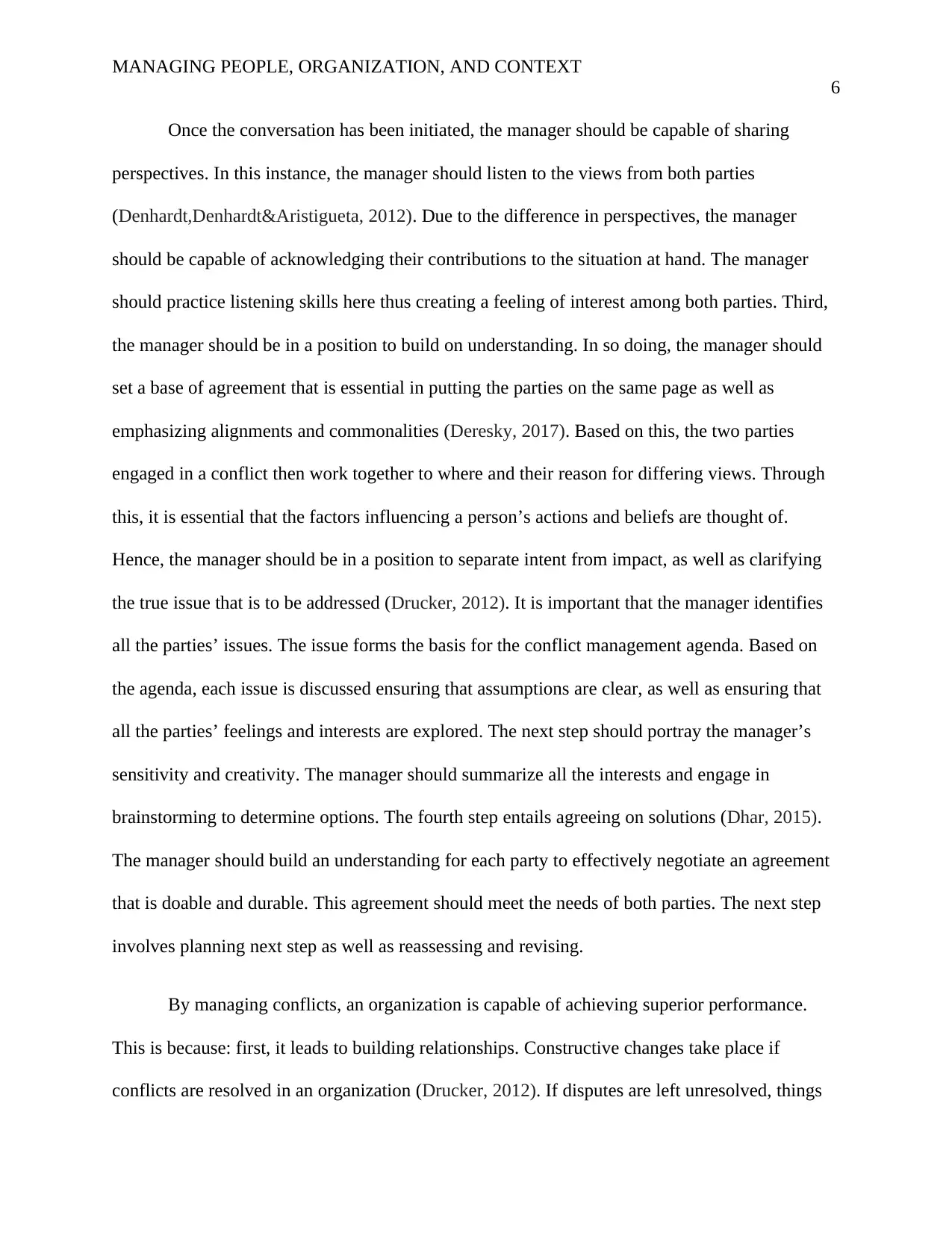
MANAGING PEOPLE, ORGANIZATION, AND CONTEXT
6
Once the conversation has been initiated, the manager should be capable of sharing
perspectives. In this instance, the manager should listen to the views from both parties
(Denhardt,Denhardt&Aristigueta, 2012). Due to the difference in perspectives, the manager
should be capable of acknowledging their contributions to the situation at hand. The manager
should practice listening skills here thus creating a feeling of interest among both parties. Third,
the manager should be in a position to build on understanding. In so doing, the manager should
set a base of agreement that is essential in putting the parties on the same page as well as
emphasizing alignments and commonalities (Deresky, 2017). Based on this, the two parties
engaged in a conflict then work together to where and their reason for differing views. Through
this, it is essential that the factors influencing a person’s actions and beliefs are thought of.
Hence, the manager should be in a position to separate intent from impact, as well as clarifying
the true issue that is to be addressed (Drucker, 2012). It is important that the manager identifies
all the parties’ issues. The issue forms the basis for the conflict management agenda. Based on
the agenda, each issue is discussed ensuring that assumptions are clear, as well as ensuring that
all the parties’ feelings and interests are explored. The next step should portray the manager’s
sensitivity and creativity. The manager should summarize all the interests and engage in
brainstorming to determine options. The fourth step entails agreeing on solutions (Dhar, 2015).
The manager should build an understanding for each party to effectively negotiate an agreement
that is doable and durable. This agreement should meet the needs of both parties. The next step
involves planning next step as well as reassessing and revising.
By managing conflicts, an organization is capable of achieving superior performance.
This is because: first, it leads to building relationships. Constructive changes take place if
conflicts are resolved in an organization (Drucker, 2012). If disputes are left unresolved, things
6
Once the conversation has been initiated, the manager should be capable of sharing
perspectives. In this instance, the manager should listen to the views from both parties
(Denhardt,Denhardt&Aristigueta, 2012). Due to the difference in perspectives, the manager
should be capable of acknowledging their contributions to the situation at hand. The manager
should practice listening skills here thus creating a feeling of interest among both parties. Third,
the manager should be in a position to build on understanding. In so doing, the manager should
set a base of agreement that is essential in putting the parties on the same page as well as
emphasizing alignments and commonalities (Deresky, 2017). Based on this, the two parties
engaged in a conflict then work together to where and their reason for differing views. Through
this, it is essential that the factors influencing a person’s actions and beliefs are thought of.
Hence, the manager should be in a position to separate intent from impact, as well as clarifying
the true issue that is to be addressed (Drucker, 2012). It is important that the manager identifies
all the parties’ issues. The issue forms the basis for the conflict management agenda. Based on
the agenda, each issue is discussed ensuring that assumptions are clear, as well as ensuring that
all the parties’ feelings and interests are explored. The next step should portray the manager’s
sensitivity and creativity. The manager should summarize all the interests and engage in
brainstorming to determine options. The fourth step entails agreeing on solutions (Dhar, 2015).
The manager should build an understanding for each party to effectively negotiate an agreement
that is doable and durable. This agreement should meet the needs of both parties. The next step
involves planning next step as well as reassessing and revising.
By managing conflicts, an organization is capable of achieving superior performance.
This is because: first, it leads to building relationships. Constructive changes take place if
conflicts are resolved in an organization (Drucker, 2012). If disputes are left unresolved, things
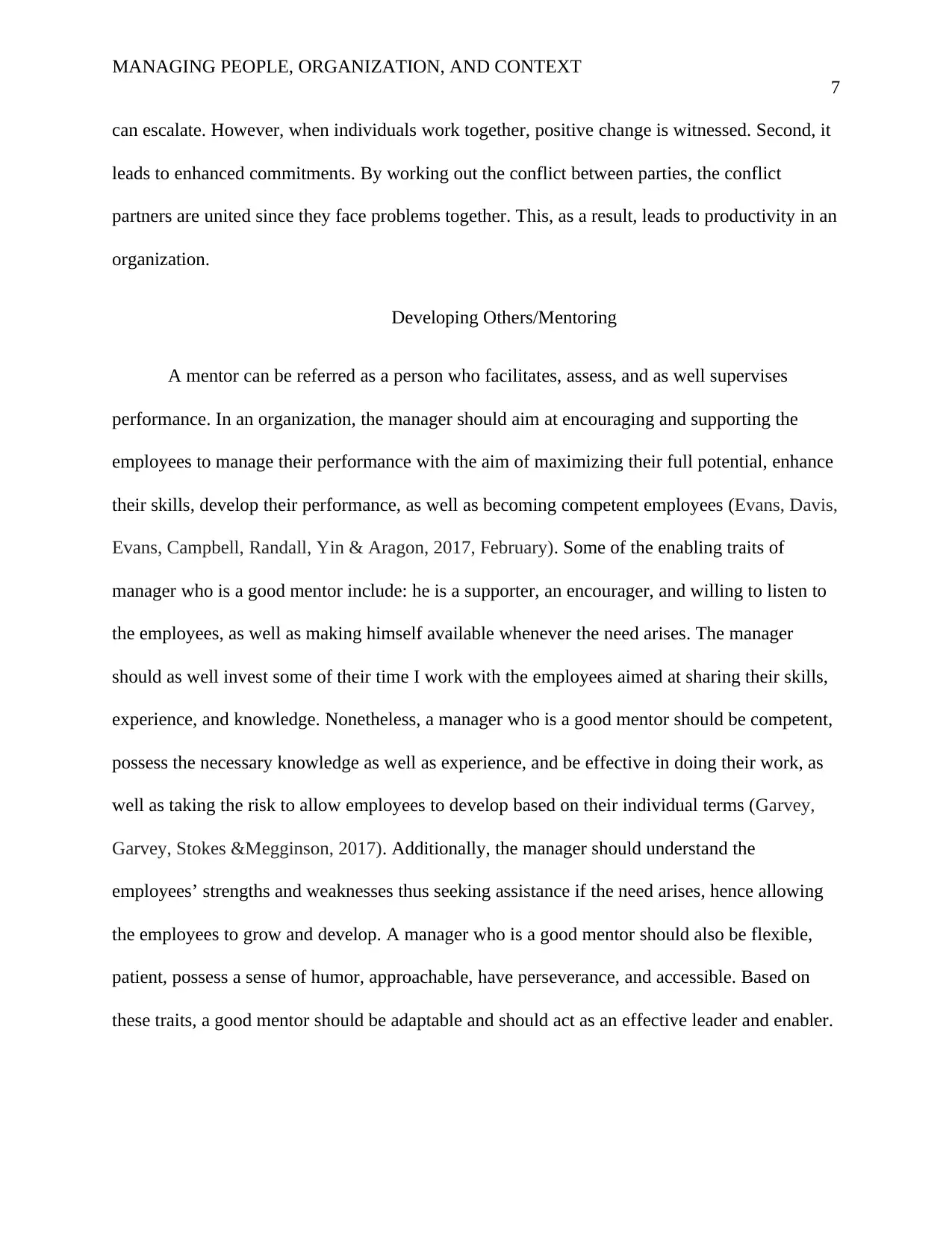
MANAGING PEOPLE, ORGANIZATION, AND CONTEXT
7
can escalate. However, when individuals work together, positive change is witnessed. Second, it
leads to enhanced commitments. By working out the conflict between parties, the conflict
partners are united since they face problems together. This, as a result, leads to productivity in an
organization.
Developing Others/Mentoring
A mentor can be referred as a person who facilitates, assess, and as well supervises
performance. In an organization, the manager should aim at encouraging and supporting the
employees to manage their performance with the aim of maximizing their full potential, enhance
their skills, develop their performance, as well as becoming competent employees (Evans, Davis,
Evans, Campbell, Randall, Yin & Aragon, 2017, February). Some of the enabling traits of
manager who is a good mentor include: he is a supporter, an encourager, and willing to listen to
the employees, as well as making himself available whenever the need arises. The manager
should as well invest some of their time I work with the employees aimed at sharing their skills,
experience, and knowledge. Nonetheless, a manager who is a good mentor should be competent,
possess the necessary knowledge as well as experience, and be effective in doing their work, as
well as taking the risk to allow employees to develop based on their individual terms (Garvey,
Garvey, Stokes &Megginson, 2017). Additionally, the manager should understand the
employees’ strengths and weaknesses thus seeking assistance if the need arises, hence allowing
the employees to grow and develop. A manager who is a good mentor should also be flexible,
patient, possess a sense of humor, approachable, have perseverance, and accessible. Based on
these traits, a good mentor should be adaptable and should act as an effective leader and enabler.
7
can escalate. However, when individuals work together, positive change is witnessed. Second, it
leads to enhanced commitments. By working out the conflict between parties, the conflict
partners are united since they face problems together. This, as a result, leads to productivity in an
organization.
Developing Others/Mentoring
A mentor can be referred as a person who facilitates, assess, and as well supervises
performance. In an organization, the manager should aim at encouraging and supporting the
employees to manage their performance with the aim of maximizing their full potential, enhance
their skills, develop their performance, as well as becoming competent employees (Evans, Davis,
Evans, Campbell, Randall, Yin & Aragon, 2017, February). Some of the enabling traits of
manager who is a good mentor include: he is a supporter, an encourager, and willing to listen to
the employees, as well as making himself available whenever the need arises. The manager
should as well invest some of their time I work with the employees aimed at sharing their skills,
experience, and knowledge. Nonetheless, a manager who is a good mentor should be competent,
possess the necessary knowledge as well as experience, and be effective in doing their work, as
well as taking the risk to allow employees to develop based on their individual terms (Garvey,
Garvey, Stokes &Megginson, 2017). Additionally, the manager should understand the
employees’ strengths and weaknesses thus seeking assistance if the need arises, hence allowing
the employees to grow and develop. A manager who is a good mentor should also be flexible,
patient, possess a sense of humor, approachable, have perseverance, and accessible. Based on
these traits, a good mentor should be adaptable and should act as an effective leader and enabler.
Paraphrase This Document
Need a fresh take? Get an instant paraphrase of this document with our AI Paraphraser

MANAGING PEOPLE, ORGANIZATION, AND CONTEXT
8
Social learning is an essential tool that enables people to measure output as well as
others’ behavior impact, thus, the people are capable of understanding the consequences of their
action. Based on the above theory, effective managers that are mentors will be in a position to
structure the manner which the mentor their employees to facilitate effective learning (Haque,
Faizan, Zehra, Baloch, Nadda&Riaz, 2015). The managers should possess a positive attitude to
their work as well as be comfortable in the manner they carry out their roles. Nonetheless, the
manager should be kept on giving the workers positive and constructive feedback, thus enabling
them to acknowledge their progress, which areas they need to improve on, as well as guiding
them the best way to go about it. As a result, this will improve their competence and motivate
them as well as create the feeling of being valued as being part of a team (Maxwell, 2018). This
is helpful in building the employees’ confidence as well as enhancing their performance, as they
incorporate it in their skill and behavior. Thus, the employees would be encouraged to perform
even harder with the intention of pleasing the manager more as well as developing their skills
further to become competent employees. This would result in increased production and
performance within the organization.
Since managers that are good mentors work alongside the employees, this may result in
workers copying some behavior and attitudes that are harmful. As such, managers should be
aware of the impacts that they have on the workers’ learning of professional attitudes as well as
skills (Jaferian, Hawkey, Sotirakopoulos, Velez-Rojas &Beznosov, 2014). The manager should
try as much as they can to engage their employees in professional activities by inspiring,
encouraging, and motivating the employees since they employees are less likely to repeat a
response that was observed, not unless they are motivated to do so. In further responding to the
employees’ needs, the managers should be capable of recognizing them as an individual and
8
Social learning is an essential tool that enables people to measure output as well as
others’ behavior impact, thus, the people are capable of understanding the consequences of their
action. Based on the above theory, effective managers that are mentors will be in a position to
structure the manner which the mentor their employees to facilitate effective learning (Haque,
Faizan, Zehra, Baloch, Nadda&Riaz, 2015). The managers should possess a positive attitude to
their work as well as be comfortable in the manner they carry out their roles. Nonetheless, the
manager should be kept on giving the workers positive and constructive feedback, thus enabling
them to acknowledge their progress, which areas they need to improve on, as well as guiding
them the best way to go about it. As a result, this will improve their competence and motivate
them as well as create the feeling of being valued as being part of a team (Maxwell, 2018). This
is helpful in building the employees’ confidence as well as enhancing their performance, as they
incorporate it in their skill and behavior. Thus, the employees would be encouraged to perform
even harder with the intention of pleasing the manager more as well as developing their skills
further to become competent employees. This would result in increased production and
performance within the organization.
Since managers that are good mentors work alongside the employees, this may result in
workers copying some behavior and attitudes that are harmful. As such, managers should be
aware of the impacts that they have on the workers’ learning of professional attitudes as well as
skills (Jaferian, Hawkey, Sotirakopoulos, Velez-Rojas &Beznosov, 2014). The manager should
try as much as they can to engage their employees in professional activities by inspiring,
encouraging, and motivating the employees since they employees are less likely to repeat a
response that was observed, not unless they are motivated to do so. In further responding to the
employees’ needs, the managers should be capable of recognizing them as an individual and
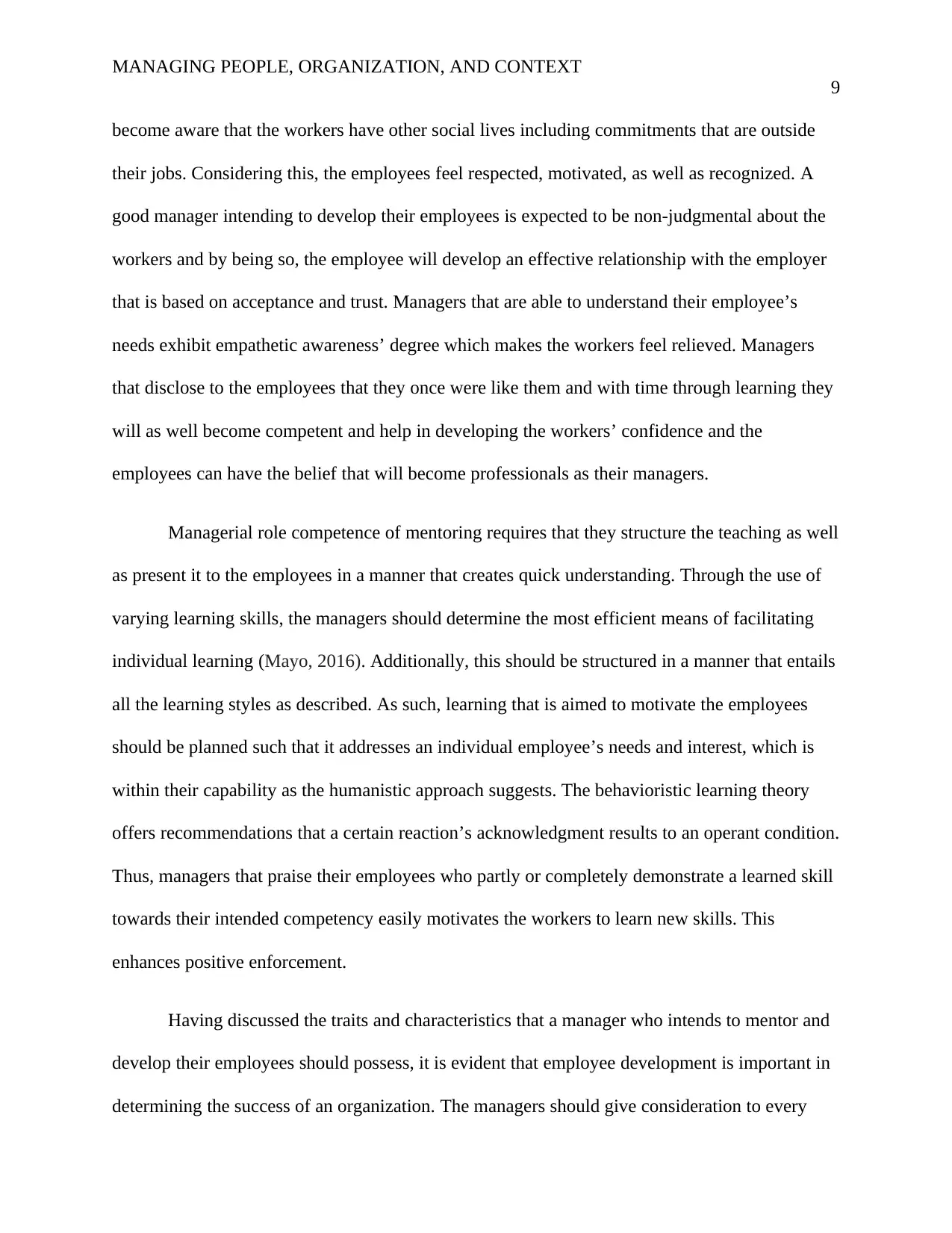
MANAGING PEOPLE, ORGANIZATION, AND CONTEXT
9
become aware that the workers have other social lives including commitments that are outside
their jobs. Considering this, the employees feel respected, motivated, as well as recognized. A
good manager intending to develop their employees is expected to be non-judgmental about the
workers and by being so, the employee will develop an effective relationship with the employer
that is based on acceptance and trust. Managers that are able to understand their employee’s
needs exhibit empathetic awareness’ degree which makes the workers feel relieved. Managers
that disclose to the employees that they once were like them and with time through learning they
will as well become competent and help in developing the workers’ confidence and the
employees can have the belief that will become professionals as their managers.
Managerial role competence of mentoring requires that they structure the teaching as well
as present it to the employees in a manner that creates quick understanding. Through the use of
varying learning skills, the managers should determine the most efficient means of facilitating
individual learning (Mayo, 2016). Additionally, this should be structured in a manner that entails
all the learning styles as described. As such, learning that is aimed to motivate the employees
should be planned such that it addresses an individual employee’s needs and interest, which is
within their capability as the humanistic approach suggests. The behavioristic learning theory
offers recommendations that a certain reaction’s acknowledgment results to an operant condition.
Thus, managers that praise their employees who partly or completely demonstrate a learned skill
towards their intended competency easily motivates the workers to learn new skills. This
enhances positive enforcement.
Having discussed the traits and characteristics that a manager who intends to mentor and
develop their employees should possess, it is evident that employee development is important in
determining the success of an organization. The managers should give consideration to every
9
become aware that the workers have other social lives including commitments that are outside
their jobs. Considering this, the employees feel respected, motivated, as well as recognized. A
good manager intending to develop their employees is expected to be non-judgmental about the
workers and by being so, the employee will develop an effective relationship with the employer
that is based on acceptance and trust. Managers that are able to understand their employee’s
needs exhibit empathetic awareness’ degree which makes the workers feel relieved. Managers
that disclose to the employees that they once were like them and with time through learning they
will as well become competent and help in developing the workers’ confidence and the
employees can have the belief that will become professionals as their managers.
Managerial role competence of mentoring requires that they structure the teaching as well
as present it to the employees in a manner that creates quick understanding. Through the use of
varying learning skills, the managers should determine the most efficient means of facilitating
individual learning (Mayo, 2016). Additionally, this should be structured in a manner that entails
all the learning styles as described. As such, learning that is aimed to motivate the employees
should be planned such that it addresses an individual employee’s needs and interest, which is
within their capability as the humanistic approach suggests. The behavioristic learning theory
offers recommendations that a certain reaction’s acknowledgment results to an operant condition.
Thus, managers that praise their employees who partly or completely demonstrate a learned skill
towards their intended competency easily motivates the workers to learn new skills. This
enhances positive enforcement.
Having discussed the traits and characteristics that a manager who intends to mentor and
develop their employees should possess, it is evident that employee development is important in
determining the success of an organization. The managers should give consideration to every
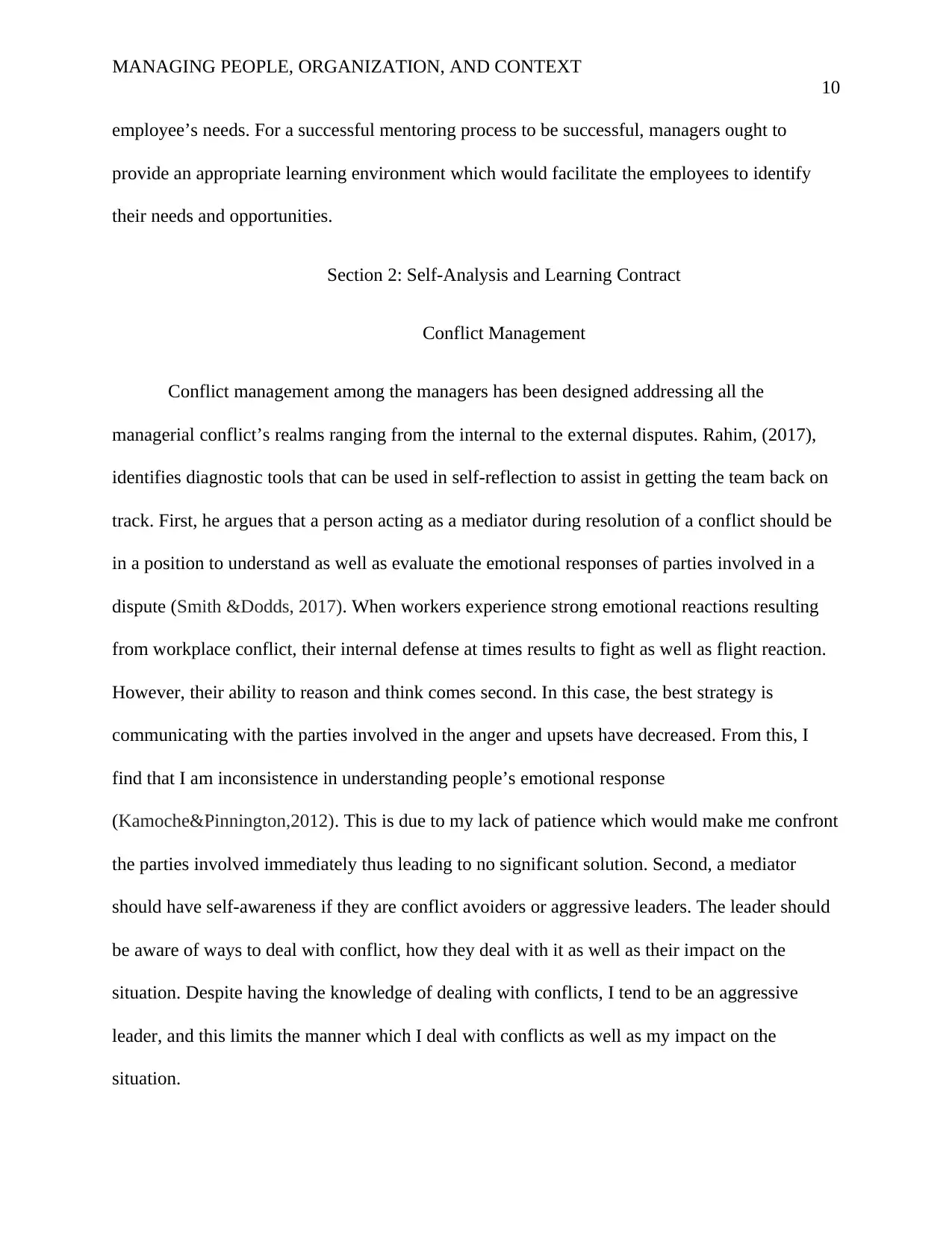
MANAGING PEOPLE, ORGANIZATION, AND CONTEXT
10
employee’s needs. For a successful mentoring process to be successful, managers ought to
provide an appropriate learning environment which would facilitate the employees to identify
their needs and opportunities.
Section 2: Self-Analysis and Learning Contract
Conflict Management
Conflict management among the managers has been designed addressing all the
managerial conflict’s realms ranging from the internal to the external disputes. Rahim, (2017),
identifies diagnostic tools that can be used in self-reflection to assist in getting the team back on
track. First, he argues that a person acting as a mediator during resolution of a conflict should be
in a position to understand as well as evaluate the emotional responses of parties involved in a
dispute (Smith &Dodds, 2017). When workers experience strong emotional reactions resulting
from workplace conflict, their internal defense at times results to fight as well as flight reaction.
However, their ability to reason and think comes second. In this case, the best strategy is
communicating with the parties involved in the anger and upsets have decreased. From this, I
find that I am inconsistence in understanding people’s emotional response
(Kamoche&Pinnington,2012). This is due to my lack of patience which would make me confront
the parties involved immediately thus leading to no significant solution. Second, a mediator
should have self-awareness if they are conflict avoiders or aggressive leaders. The leader should
be aware of ways to deal with conflict, how they deal with it as well as their impact on the
situation. Despite having the knowledge of dealing with conflicts, I tend to be an aggressive
leader, and this limits the manner which I deal with conflicts as well as my impact on the
situation.
10
employee’s needs. For a successful mentoring process to be successful, managers ought to
provide an appropriate learning environment which would facilitate the employees to identify
their needs and opportunities.
Section 2: Self-Analysis and Learning Contract
Conflict Management
Conflict management among the managers has been designed addressing all the
managerial conflict’s realms ranging from the internal to the external disputes. Rahim, (2017),
identifies diagnostic tools that can be used in self-reflection to assist in getting the team back on
track. First, he argues that a person acting as a mediator during resolution of a conflict should be
in a position to understand as well as evaluate the emotional responses of parties involved in a
dispute (Smith &Dodds, 2017). When workers experience strong emotional reactions resulting
from workplace conflict, their internal defense at times results to fight as well as flight reaction.
However, their ability to reason and think comes second. In this case, the best strategy is
communicating with the parties involved in the anger and upsets have decreased. From this, I
find that I am inconsistence in understanding people’s emotional response
(Kamoche&Pinnington,2012). This is due to my lack of patience which would make me confront
the parties involved immediately thus leading to no significant solution. Second, a mediator
should have self-awareness if they are conflict avoiders or aggressive leaders. The leader should
be aware of ways to deal with conflict, how they deal with it as well as their impact on the
situation. Despite having the knowledge of dealing with conflicts, I tend to be an aggressive
leader, and this limits the manner which I deal with conflicts as well as my impact on the
situation.
Secure Best Marks with AI Grader
Need help grading? Try our AI Grader for instant feedback on your assignments.
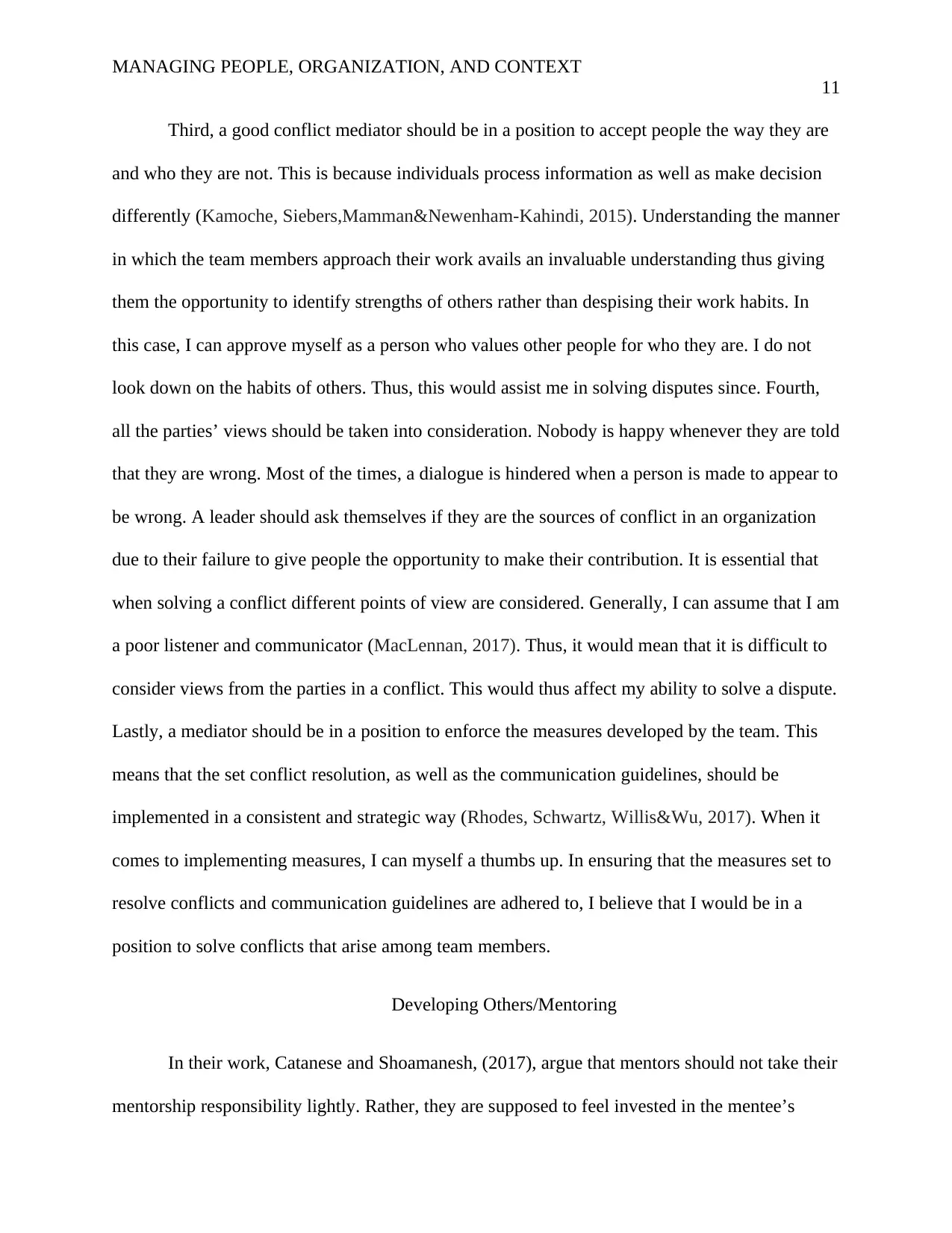
MANAGING PEOPLE, ORGANIZATION, AND CONTEXT
11
Third, a good conflict mediator should be in a position to accept people the way they are
and who they are not. This is because individuals process information as well as make decision
differently (Kamoche, Siebers,Mamman&Newenham-Kahindi, 2015). Understanding the manner
in which the team members approach their work avails an invaluable understanding thus giving
them the opportunity to identify strengths of others rather than despising their work habits. In
this case, I can approve myself as a person who values other people for who they are. I do not
look down on the habits of others. Thus, this would assist me in solving disputes since. Fourth,
all the parties’ views should be taken into consideration. Nobody is happy whenever they are told
that they are wrong. Most of the times, a dialogue is hindered when a person is made to appear to
be wrong. A leader should ask themselves if they are the sources of conflict in an organization
due to their failure to give people the opportunity to make their contribution. It is essential that
when solving a conflict different points of view are considered. Generally, I can assume that I am
a poor listener and communicator (MacLennan, 2017). Thus, it would mean that it is difficult to
consider views from the parties in a conflict. This would thus affect my ability to solve a dispute.
Lastly, a mediator should be in a position to enforce the measures developed by the team. This
means that the set conflict resolution, as well as the communication guidelines, should be
implemented in a consistent and strategic way (Rhodes, Schwartz, Willis&Wu, 2017). When it
comes to implementing measures, I can myself a thumbs up. In ensuring that the measures set to
resolve conflicts and communication guidelines are adhered to, I believe that I would be in a
position to solve conflicts that arise among team members.
Developing Others/Mentoring
In their work, Catanese and Shoamanesh, (2017), argue that mentors should not take their
mentorship responsibility lightly. Rather, they are supposed to feel invested in the mentee’s
11
Third, a good conflict mediator should be in a position to accept people the way they are
and who they are not. This is because individuals process information as well as make decision
differently (Kamoche, Siebers,Mamman&Newenham-Kahindi, 2015). Understanding the manner
in which the team members approach their work avails an invaluable understanding thus giving
them the opportunity to identify strengths of others rather than despising their work habits. In
this case, I can approve myself as a person who values other people for who they are. I do not
look down on the habits of others. Thus, this would assist me in solving disputes since. Fourth,
all the parties’ views should be taken into consideration. Nobody is happy whenever they are told
that they are wrong. Most of the times, a dialogue is hindered when a person is made to appear to
be wrong. A leader should ask themselves if they are the sources of conflict in an organization
due to their failure to give people the opportunity to make their contribution. It is essential that
when solving a conflict different points of view are considered. Generally, I can assume that I am
a poor listener and communicator (MacLennan, 2017). Thus, it would mean that it is difficult to
consider views from the parties in a conflict. This would thus affect my ability to solve a dispute.
Lastly, a mediator should be in a position to enforce the measures developed by the team. This
means that the set conflict resolution, as well as the communication guidelines, should be
implemented in a consistent and strategic way (Rhodes, Schwartz, Willis&Wu, 2017). When it
comes to implementing measures, I can myself a thumbs up. In ensuring that the measures set to
resolve conflicts and communication guidelines are adhered to, I believe that I would be in a
position to solve conflicts that arise among team members.
Developing Others/Mentoring
In their work, Catanese and Shoamanesh, (2017), argue that mentors should not take their
mentorship responsibility lightly. Rather, they are supposed to feel invested in the mentee’s
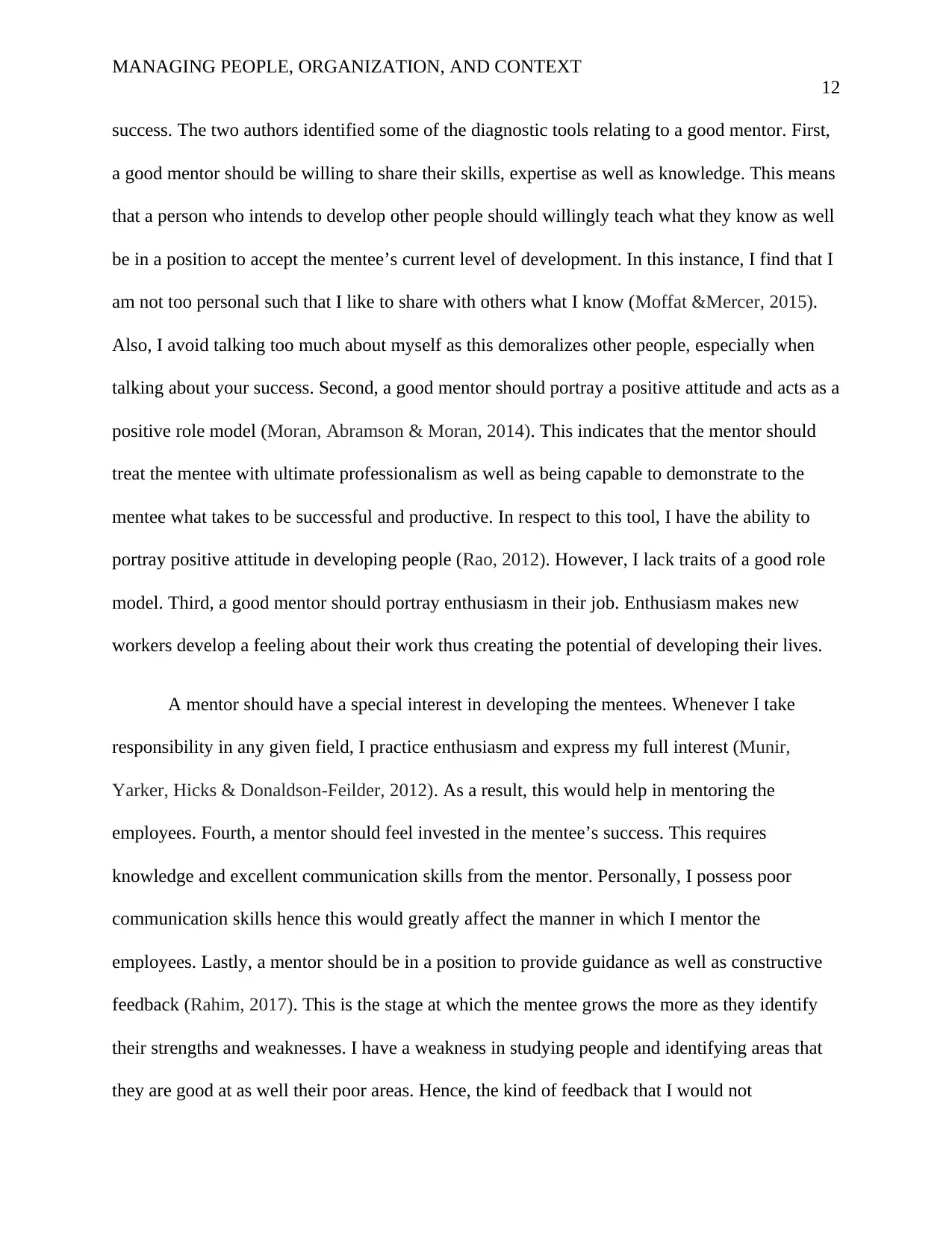
MANAGING PEOPLE, ORGANIZATION, AND CONTEXT
12
success. The two authors identified some of the diagnostic tools relating to a good mentor. First,
a good mentor should be willing to share their skills, expertise as well as knowledge. This means
that a person who intends to develop other people should willingly teach what they know as well
be in a position to accept the mentee’s current level of development. In this instance, I find that I
am not too personal such that I like to share with others what I know (Moffat &Mercer, 2015).
Also, I avoid talking too much about myself as this demoralizes other people, especially when
talking about your success. Second, a good mentor should portray a positive attitude and acts as a
positive role model (Moran, Abramson & Moran, 2014). This indicates that the mentor should
treat the mentee with ultimate professionalism as well as being capable to demonstrate to the
mentee what takes to be successful and productive. In respect to this tool, I have the ability to
portray positive attitude in developing people (Rao, 2012). However, I lack traits of a good role
model. Third, a good mentor should portray enthusiasm in their job. Enthusiasm makes new
workers develop a feeling about their work thus creating the potential of developing their lives.
A mentor should have a special interest in developing the mentees. Whenever I take
responsibility in any given field, I practice enthusiasm and express my full interest (Munir,
Yarker, Hicks & Donaldson-Feilder, 2012). As a result, this would help in mentoring the
employees. Fourth, a mentor should feel invested in the mentee’s success. This requires
knowledge and excellent communication skills from the mentor. Personally, I possess poor
communication skills hence this would greatly affect the manner in which I mentor the
employees. Lastly, a mentor should be in a position to provide guidance as well as constructive
feedback (Rahim, 2017). This is the stage at which the mentee grows the more as they identify
their strengths and weaknesses. I have a weakness in studying people and identifying areas that
they are good at as well their poor areas. Hence, the kind of feedback that I would not
12
success. The two authors identified some of the diagnostic tools relating to a good mentor. First,
a good mentor should be willing to share their skills, expertise as well as knowledge. This means
that a person who intends to develop other people should willingly teach what they know as well
be in a position to accept the mentee’s current level of development. In this instance, I find that I
am not too personal such that I like to share with others what I know (Moffat &Mercer, 2015).
Also, I avoid talking too much about myself as this demoralizes other people, especially when
talking about your success. Second, a good mentor should portray a positive attitude and acts as a
positive role model (Moran, Abramson & Moran, 2014). This indicates that the mentor should
treat the mentee with ultimate professionalism as well as being capable to demonstrate to the
mentee what takes to be successful and productive. In respect to this tool, I have the ability to
portray positive attitude in developing people (Rao, 2012). However, I lack traits of a good role
model. Third, a good mentor should portray enthusiasm in their job. Enthusiasm makes new
workers develop a feeling about their work thus creating the potential of developing their lives.
A mentor should have a special interest in developing the mentees. Whenever I take
responsibility in any given field, I practice enthusiasm and express my full interest (Munir,
Yarker, Hicks & Donaldson-Feilder, 2012). As a result, this would help in mentoring the
employees. Fourth, a mentor should feel invested in the mentee’s success. This requires
knowledge and excellent communication skills from the mentor. Personally, I possess poor
communication skills hence this would greatly affect the manner in which I mentor the
employees. Lastly, a mentor should be in a position to provide guidance as well as constructive
feedback (Rahim, 2017). This is the stage at which the mentee grows the more as they identify
their strengths and weaknesses. I have a weakness in studying people and identifying areas that
they are good at as well their poor areas. Hence, the kind of feedback that I would not
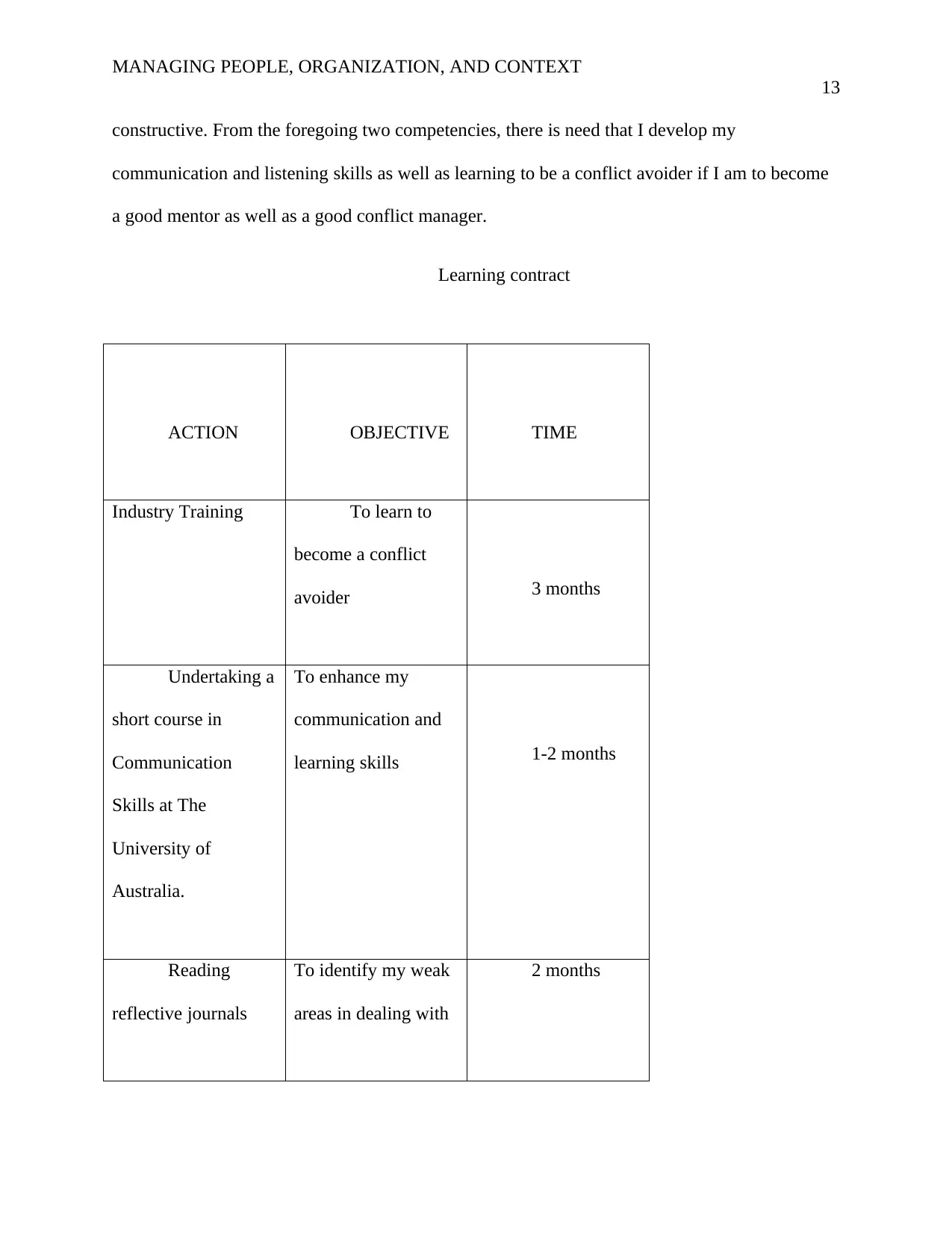
MANAGING PEOPLE, ORGANIZATION, AND CONTEXT
13
constructive. From the foregoing two competencies, there is need that I develop my
communication and listening skills as well as learning to be a conflict avoider if I am to become
a good mentor as well as a good conflict manager.
Learning contract
ACTION OBJECTIVE TIME
Industry Training To learn to
become a conflict
avoider 3 months
Undertaking a
short course in
Communication
Skills at The
University of
Australia.
To enhance my
communication and
learning skills 1-2 months
Reading
reflective journals
To identify my weak
areas in dealing with
2 months
13
constructive. From the foregoing two competencies, there is need that I develop my
communication and listening skills as well as learning to be a conflict avoider if I am to become
a good mentor as well as a good conflict manager.
Learning contract
ACTION OBJECTIVE TIME
Industry Training To learn to
become a conflict
avoider 3 months
Undertaking a
short course in
Communication
Skills at The
University of
Australia.
To enhance my
communication and
learning skills 1-2 months
Reading
reflective journals
To identify my weak
areas in dealing with
2 months
Paraphrase This Document
Need a fresh take? Get an instant paraphrase of this document with our AI Paraphraser

MANAGING PEOPLE, ORGANIZATION, AND CONTEXT
14
people.
Conclusion
The essentiality of this assignment to my professional life and its development cannot be
underestimated. It has acted as an eye-opener. It has shown me specific things that I have to do
as a professional. The reflective analysis has assisted in establishing areas that require
improvement to become a competent professional. Particularly, this reflection has enabled me to
understand that becoming a professional does not involve understanding what to do but
understanding hot to do it best. My future should focus on improving my communication and
listening skills as well becoming a good conflict avoider.
14
people.
Conclusion
The essentiality of this assignment to my professional life and its development cannot be
underestimated. It has acted as an eye-opener. It has shown me specific things that I have to do
as a professional. The reflective analysis has assisted in establishing areas that require
improvement to become a competent professional. Particularly, this reflection has enabled me to
understand that becoming a professional does not involve understanding what to do but
understanding hot to do it best. My future should focus on improving my communication and
listening skills as well becoming a good conflict avoider.
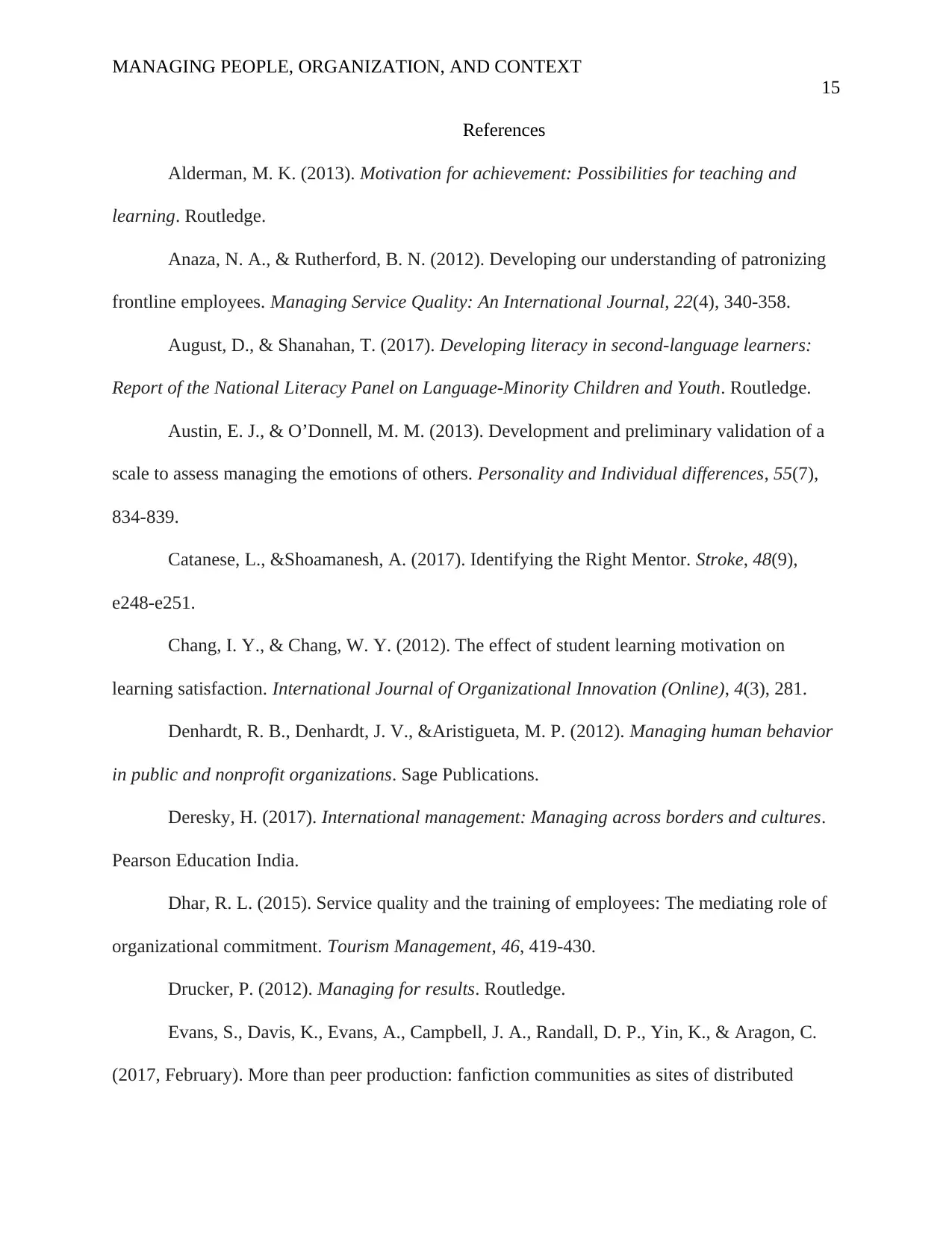
MANAGING PEOPLE, ORGANIZATION, AND CONTEXT
15
References
Alderman, M. K. (2013). Motivation for achievement: Possibilities for teaching and
learning. Routledge.
Anaza, N. A., & Rutherford, B. N. (2012). Developing our understanding of patronizing
frontline employees. Managing Service Quality: An International Journal, 22(4), 340-358.
August, D., & Shanahan, T. (2017). Developing literacy in second-language learners:
Report of the National Literacy Panel on Language-Minority Children and Youth. Routledge.
Austin, E. J., & O’Donnell, M. M. (2013). Development and preliminary validation of a
scale to assess managing the emotions of others. Personality and Individual differences, 55(7),
834-839.
Catanese, L., &Shoamanesh, A. (2017). Identifying the Right Mentor. Stroke, 48(9),
e248-e251.
Chang, I. Y., & Chang, W. Y. (2012). The effect of student learning motivation on
learning satisfaction. International Journal of Organizational Innovation (Online), 4(3), 281.
Denhardt, R. B., Denhardt, J. V., &Aristigueta, M. P. (2012). Managing human behavior
in public and nonprofit organizations. Sage Publications.
Deresky, H. (2017). International management: Managing across borders and cultures.
Pearson Education India.
Dhar, R. L. (2015). Service quality and the training of employees: The mediating role of
organizational commitment. Tourism Management, 46, 419-430.
Drucker, P. (2012). Managing for results. Routledge.
Evans, S., Davis, K., Evans, A., Campbell, J. A., Randall, D. P., Yin, K., & Aragon, C.
(2017, February). More than peer production: fanfiction communities as sites of distributed
15
References
Alderman, M. K. (2013). Motivation for achievement: Possibilities for teaching and
learning. Routledge.
Anaza, N. A., & Rutherford, B. N. (2012). Developing our understanding of patronizing
frontline employees. Managing Service Quality: An International Journal, 22(4), 340-358.
August, D., & Shanahan, T. (2017). Developing literacy in second-language learners:
Report of the National Literacy Panel on Language-Minority Children and Youth. Routledge.
Austin, E. J., & O’Donnell, M. M. (2013). Development and preliminary validation of a
scale to assess managing the emotions of others. Personality and Individual differences, 55(7),
834-839.
Catanese, L., &Shoamanesh, A. (2017). Identifying the Right Mentor. Stroke, 48(9),
e248-e251.
Chang, I. Y., & Chang, W. Y. (2012). The effect of student learning motivation on
learning satisfaction. International Journal of Organizational Innovation (Online), 4(3), 281.
Denhardt, R. B., Denhardt, J. V., &Aristigueta, M. P. (2012). Managing human behavior
in public and nonprofit organizations. Sage Publications.
Deresky, H. (2017). International management: Managing across borders and cultures.
Pearson Education India.
Dhar, R. L. (2015). Service quality and the training of employees: The mediating role of
organizational commitment. Tourism Management, 46, 419-430.
Drucker, P. (2012). Managing for results. Routledge.
Evans, S., Davis, K., Evans, A., Campbell, J. A., Randall, D. P., Yin, K., & Aragon, C.
(2017, February). More than peer production: fanfiction communities as sites of distributed
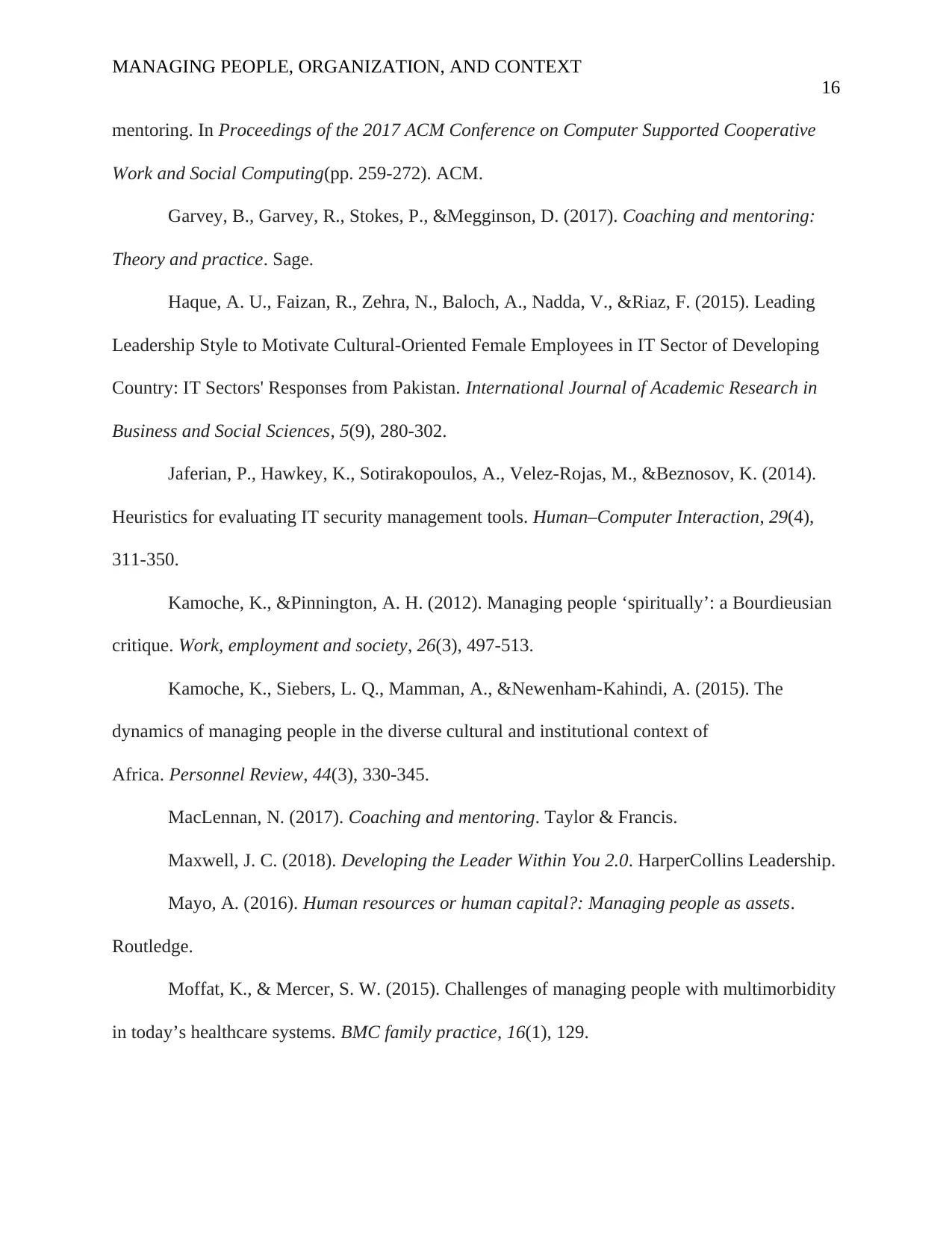
MANAGING PEOPLE, ORGANIZATION, AND CONTEXT
16
mentoring. In Proceedings of the 2017 ACM Conference on Computer Supported Cooperative
Work and Social Computing(pp. 259-272). ACM.
Garvey, B., Garvey, R., Stokes, P., &Megginson, D. (2017). Coaching and mentoring:
Theory and practice. Sage.
Haque, A. U., Faizan, R., Zehra, N., Baloch, A., Nadda, V., &Riaz, F. (2015). Leading
Leadership Style to Motivate Cultural-Oriented Female Employees in IT Sector of Developing
Country: IT Sectors' Responses from Pakistan. International Journal of Academic Research in
Business and Social Sciences, 5(9), 280-302.
Jaferian, P., Hawkey, K., Sotirakopoulos, A., Velez-Rojas, M., &Beznosov, K. (2014).
Heuristics for evaluating IT security management tools. Human–Computer Interaction, 29(4),
311-350.
Kamoche, K., &Pinnington, A. H. (2012). Managing people ‘spiritually’: a Bourdieusian
critique. Work, employment and society, 26(3), 497-513.
Kamoche, K., Siebers, L. Q., Mamman, A., &Newenham-Kahindi, A. (2015). The
dynamics of managing people in the diverse cultural and institutional context of
Africa. Personnel Review, 44(3), 330-345.
MacLennan, N. (2017). Coaching and mentoring. Taylor & Francis.
Maxwell, J. C. (2018). Developing the Leader Within You 2.0. HarperCollins Leadership.
Mayo, A. (2016). Human resources or human capital?: Managing people as assets.
Routledge.
Moffat, K., & Mercer, S. W. (2015). Challenges of managing people with multimorbidity
in today’s healthcare systems. BMC family practice, 16(1), 129.
16
mentoring. In Proceedings of the 2017 ACM Conference on Computer Supported Cooperative
Work and Social Computing(pp. 259-272). ACM.
Garvey, B., Garvey, R., Stokes, P., &Megginson, D. (2017). Coaching and mentoring:
Theory and practice. Sage.
Haque, A. U., Faizan, R., Zehra, N., Baloch, A., Nadda, V., &Riaz, F. (2015). Leading
Leadership Style to Motivate Cultural-Oriented Female Employees in IT Sector of Developing
Country: IT Sectors' Responses from Pakistan. International Journal of Academic Research in
Business and Social Sciences, 5(9), 280-302.
Jaferian, P., Hawkey, K., Sotirakopoulos, A., Velez-Rojas, M., &Beznosov, K. (2014).
Heuristics for evaluating IT security management tools. Human–Computer Interaction, 29(4),
311-350.
Kamoche, K., &Pinnington, A. H. (2012). Managing people ‘spiritually’: a Bourdieusian
critique. Work, employment and society, 26(3), 497-513.
Kamoche, K., Siebers, L. Q., Mamman, A., &Newenham-Kahindi, A. (2015). The
dynamics of managing people in the diverse cultural and institutional context of
Africa. Personnel Review, 44(3), 330-345.
MacLennan, N. (2017). Coaching and mentoring. Taylor & Francis.
Maxwell, J. C. (2018). Developing the Leader Within You 2.0. HarperCollins Leadership.
Mayo, A. (2016). Human resources or human capital?: Managing people as assets.
Routledge.
Moffat, K., & Mercer, S. W. (2015). Challenges of managing people with multimorbidity
in today’s healthcare systems. BMC family practice, 16(1), 129.
Secure Best Marks with AI Grader
Need help grading? Try our AI Grader for instant feedback on your assignments.
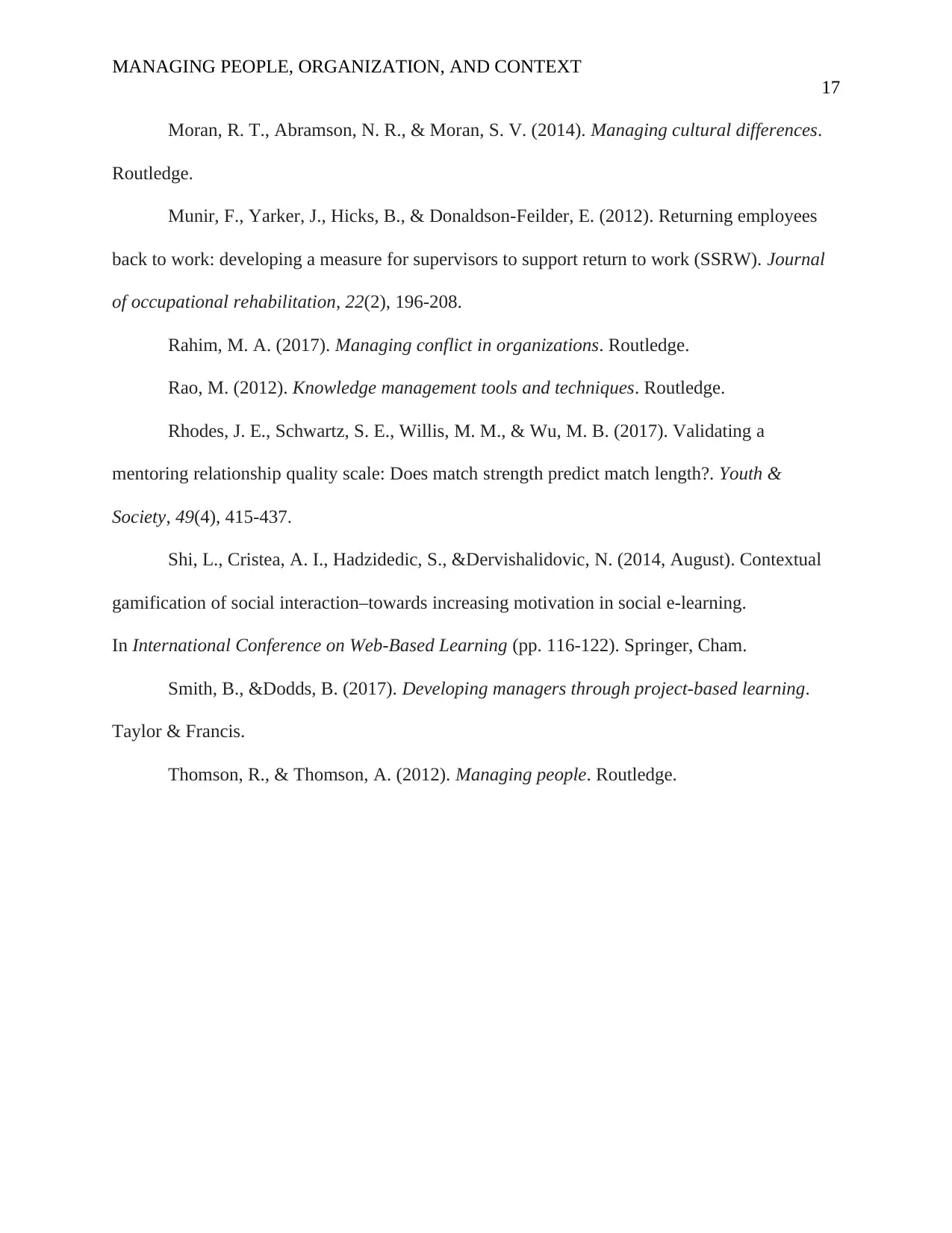
MANAGING PEOPLE, ORGANIZATION, AND CONTEXT
17
Moran, R. T., Abramson, N. R., & Moran, S. V. (2014). Managing cultural differences.
Routledge.
Munir, F., Yarker, J., Hicks, B., & Donaldson-Feilder, E. (2012). Returning employees
back to work: developing a measure for supervisors to support return to work (SSRW). Journal
of occupational rehabilitation, 22(2), 196-208.
Rahim, M. A. (2017). Managing conflict in organizations. Routledge.
Rao, M. (2012). Knowledge management tools and techniques. Routledge.
Rhodes, J. E., Schwartz, S. E., Willis, M. M., & Wu, M. B. (2017). Validating a
mentoring relationship quality scale: Does match strength predict match length?. Youth &
Society, 49(4), 415-437.
Shi, L., Cristea, A. I., Hadzidedic, S., &Dervishalidovic, N. (2014, August). Contextual
gamification of social interaction–towards increasing motivation in social e-learning.
In International Conference on Web-Based Learning (pp. 116-122). Springer, Cham.
Smith, B., &Dodds, B. (2017). Developing managers through project-based learning.
Taylor & Francis.
Thomson, R., & Thomson, A. (2012). Managing people. Routledge.
17
Moran, R. T., Abramson, N. R., & Moran, S. V. (2014). Managing cultural differences.
Routledge.
Munir, F., Yarker, J., Hicks, B., & Donaldson-Feilder, E. (2012). Returning employees
back to work: developing a measure for supervisors to support return to work (SSRW). Journal
of occupational rehabilitation, 22(2), 196-208.
Rahim, M. A. (2017). Managing conflict in organizations. Routledge.
Rao, M. (2012). Knowledge management tools and techniques. Routledge.
Rhodes, J. E., Schwartz, S. E., Willis, M. M., & Wu, M. B. (2017). Validating a
mentoring relationship quality scale: Does match strength predict match length?. Youth &
Society, 49(4), 415-437.
Shi, L., Cristea, A. I., Hadzidedic, S., &Dervishalidovic, N. (2014, August). Contextual
gamification of social interaction–towards increasing motivation in social e-learning.
In International Conference on Web-Based Learning (pp. 116-122). Springer, Cham.
Smith, B., &Dodds, B. (2017). Developing managers through project-based learning.
Taylor & Francis.
Thomson, R., & Thomson, A. (2012). Managing people. Routledge.
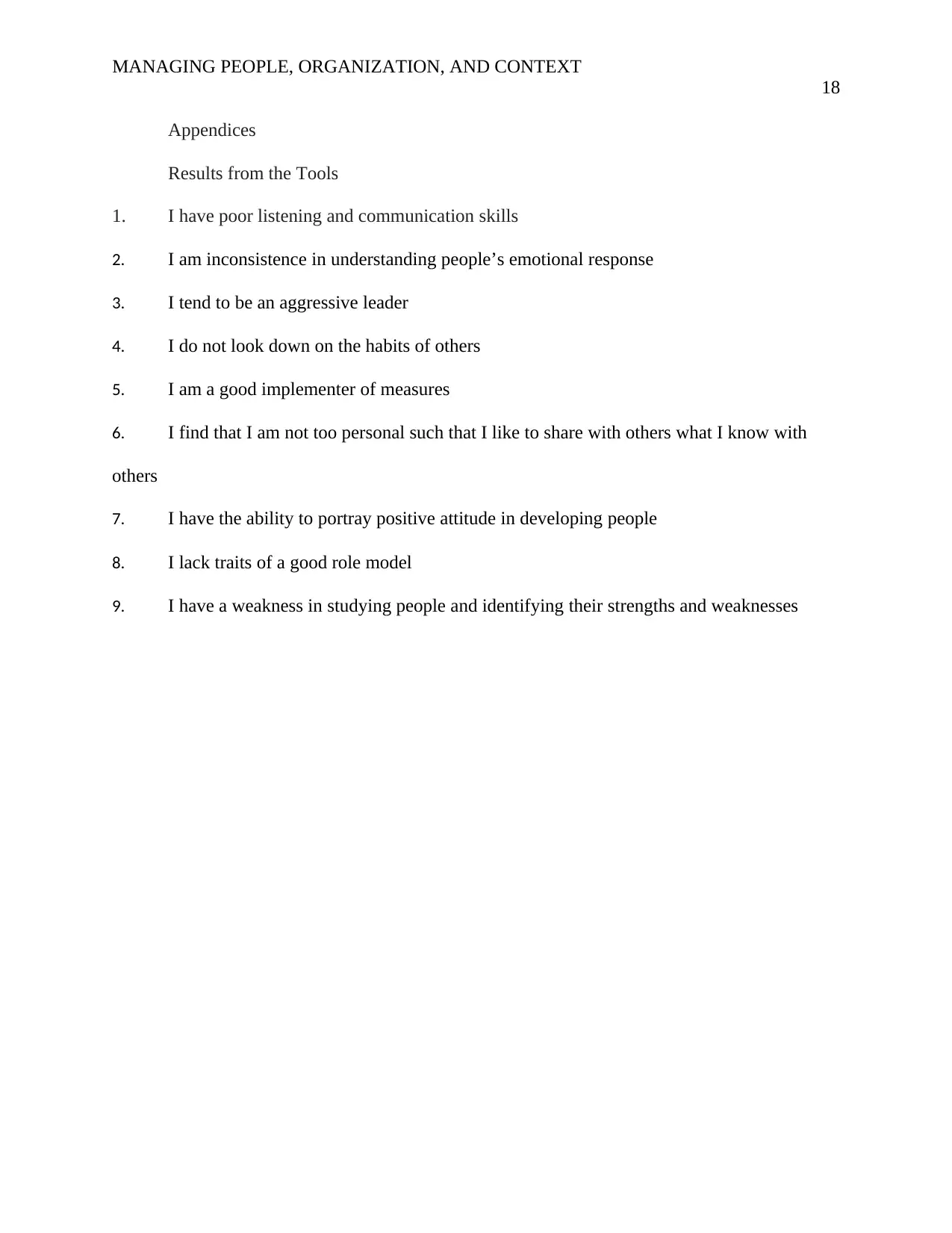
MANAGING PEOPLE, ORGANIZATION, AND CONTEXT
18
Appendices
Results from the Tools
1. I have poor listening and communication skills
2. I am inconsistence in understanding people’s emotional response
3. I tend to be an aggressive leader
4. I do not look down on the habits of others
5. I am a good implementer of measures
6. I find that I am not too personal such that I like to share with others what I know with
others
7. I have the ability to portray positive attitude in developing people
8. I lack traits of a good role model
9. I have a weakness in studying people and identifying their strengths and weaknesses
18
Appendices
Results from the Tools
1. I have poor listening and communication skills
2. I am inconsistence in understanding people’s emotional response
3. I tend to be an aggressive leader
4. I do not look down on the habits of others
5. I am a good implementer of measures
6. I find that I am not too personal such that I like to share with others what I know with
others
7. I have the ability to portray positive attitude in developing people
8. I lack traits of a good role model
9. I have a weakness in studying people and identifying their strengths and weaknesses
1 out of 18
Related Documents
Your All-in-One AI-Powered Toolkit for Academic Success.
+13062052269
info@desklib.com
Available 24*7 on WhatsApp / Email
![[object Object]](/_next/static/media/star-bottom.7253800d.svg)
Unlock your academic potential
© 2024 | Zucol Services PVT LTD | All rights reserved.





